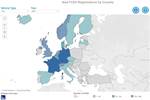Talgo announces launch of hydrogen train by 2023
The new system will be configured as a modular solution that can be installed on all types of trains, as well as for upgrading previous diesel versions to hydrogen.

Rendition of the Talgo Vittal-One. Photo Credit: Talgo S.A.
Talgo S.A. (Spain) a company that focuses on the design, manufacture and maintenance of light, high-speed trains, reported on Nov. 19 that the timetable for the manufacture and launch of its hydrogen train — a green, innovative and efficient alternative to replacing diesel engines — will be ready by 2023. The details of the train, named Talgo Vittal-One in reference to hydrogen’s placement in the periodic table, were presented during the event “Renewable hydrogen: An opportunity for Spain,” organized by the Spanish Ministry for the Ecological Transition and the Demographic Challenge.
The first phase of the validation tests of the hydrogen technology will be conducted in 2021. After the validation process, the hydrogen technology will be installed in the new train during a second manufacturing phase that will take place between 2021 and 2023.
“Green hydrogen is no longer the future, it is a reality,” stated Talgo CEO, José María Oriol, during his presentation. “The implementation of hydrogen trains, such as the one Talgo is developing, will improve mobility in our country and have a positive impact on the environment. It will allow us to make the most of the non-electrified Spanish railways while reducing our carbon footprint.”
Talgo says this system is configured as a modular solution that can be installed on all types of trains, as well as for the upgrade from diesel to hydrogen. However, it has been specifically designed for the Vittal platform for commuter and regional trains, which Talgo has presented in the bidding process for various tenders in Spain and other countries.
According to the company, its innovative system uses hydrogen batteries that provide the energy for the train's electric motors. It is powered by renewable energy sources, such as solar photovoltaic or wind, which produce hydrogen that is stored and then used to power fuel cell-based propulsion systems, such as the one designed by Talgo. The system is complemented by batteries that increase the speed of the train when it starts, taking advantage of the braking system to recharge it.
Unlike the extended battery systems in the automotive industry, says Talo, hydrogen (H2) technology is the logical answer to the needs of heavy transport and, in particular, of those railway lines that do not have catenary electrification systems, and which today depend on trains powered by diesel engines. The hydrogen system designed by Talgo is said to enable conventional network lines to be “electrified” without the need for costly and lengthy adaptation operations, and without the use of fossil fuels.
Related Content
-
Composites UK launches best practice guide for composites tooling
“Mould Tooling for Fibre-Reinforced Polymer Composites” is latest in Composites UK’s series of good practice guides, available online for free.
-
Materials & Processes: Fabrication methods
There are numerous methods for fabricating composite components. Selection of a method for a particular part, therefore, will depend on the materials, the part design and end-use or application. Here's a guide to selection.
-
University of Maine unveils 100% bio-based 3D-printed home
BioHome3D, made of wood fibers and bioresins and entirely 3D printed, highlights Maine’s effort to address the need for more affordable housing.















